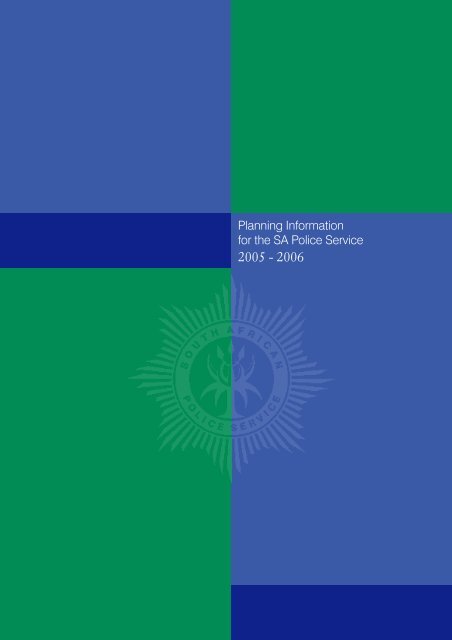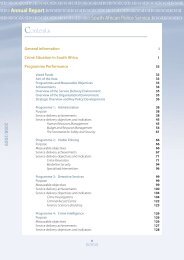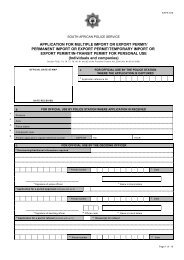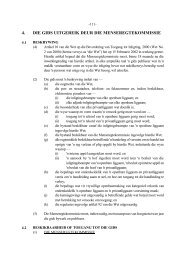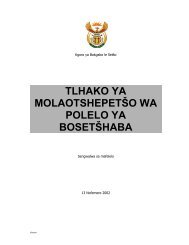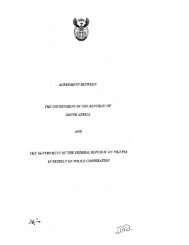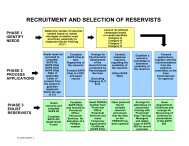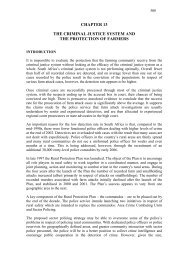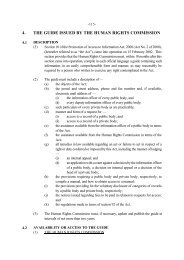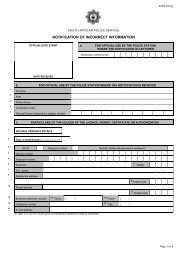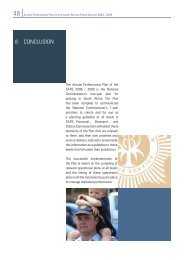Planning Information for the SAPS 2005 - 2006
Planning Information for the SAPS 2005 - 2006
Planning Information for the SAPS 2005 - 2006
You also want an ePaper? Increase the reach of your titles
YUMPU automatically turns print PDFs into web optimized ePapers that Google loves.
<strong>Planning</strong> <strong>In<strong>for</strong>mation</strong><br />
<strong>for</strong> <strong>the</strong> SA Police Service<br />
<strong>2005</strong> - <strong>2006</strong>
The <strong>Planning</strong> <strong>In<strong>for</strong>mation</strong> <strong>for</strong> <strong>the</strong> SA Police Service<br />
<strong>2005</strong> -<strong>2006</strong><br />
was compiled and edited by <strong>the</strong> Component:<br />
Strategic Management (Head Office)<br />
Design & Layout:<br />
Corporate Image<br />
<strong>SAPS</strong> Communication & Liaison Services<br />
Fur<strong>the</strong>r in<strong>for</strong>mation regarding <strong>the</strong><br />
<strong>Planning</strong> <strong>In<strong>for</strong>mation</strong> <strong>for</strong> <strong>the</strong> SA Police Service<br />
<strong>2005</strong> -<strong>2006</strong><br />
can be obtained from:<br />
The <strong>SAPS</strong> National Commissioner<br />
Private Bag X94<br />
Pretoria<br />
0001<br />
<strong>SAPS</strong> Website : http://www.saps.gov.za<br />
ISBN no: 0-621-35597-6<br />
RP no: 35/05
<strong>Planning</strong> <strong>In<strong>for</strong>mation</strong> <strong>for</strong> <strong>the</strong> SA Police Service <strong>2005</strong>-<strong>2006</strong><br />
CONTENTS<br />
Introduction 5<br />
Strategic Priorities 5<br />
Priorities and Programmes 6<br />
<strong>Planning</strong> <strong>In<strong>for</strong>mation</strong> <strong>2005</strong> / <strong>2006</strong> 7<br />
Implementation Guidelines 23<br />
Introduction 23<br />
Terminology Used in <strong>the</strong> <strong>Planning</strong> <strong>In<strong>for</strong>mation</strong> 24<br />
Description of terms 24<br />
Explanation of Indicators 26<br />
Programme 1 : Administration 26<br />
Programme 2 : Visible Policing 26<br />
Programme 3 : Detective Services 33<br />
Programme 4 : Crime Intelligence 36<br />
Programme 5 : Protection and Security Services 37<br />
Conclusion 38<br />
4
<strong>Planning</strong> <strong>In<strong>for</strong>mation</strong> <strong>for</strong> <strong>the</strong> SA Police Service <strong>2005</strong>-<strong>2006</strong><br />
1. INTRODUCTION<br />
The Police Service Act, 1995 (Act No 68 of 1995) requires <strong>the</strong> National Commissioner to<br />
develop a plan, setting out <strong>the</strong> priorities and objectives of policing <strong>for</strong> <strong>the</strong> following financial<br />
year. The <strong>Planning</strong> <strong>In<strong>for</strong>mation</strong> <strong>for</strong> <strong>2005</strong>/<strong>2006</strong> serves as <strong>the</strong> Annual Plan of <strong>the</strong> National<br />
Commissioner in this regard. This is also in line with Treasury Regulations 2002,<br />
subparagraph 5.2.2(d) which stipulates that <strong>the</strong> Strategic Plan must include inter alia,<br />
measurable objectives, expected outcomes, programme outputs, indicators and targets of <strong>the</strong><br />
institution’s programmes.<br />
2. STRATEGIC PRIORITIES<br />
The Department’s Strategic Plan <strong>for</strong> <strong>2005</strong>-2010 lays down four key strategy priorities <strong>for</strong> <strong>the</strong><br />
medium term:<br />
Combat organised crime, focussing on drug and firearm trafficking, vehicle <strong>the</strong>ft and<br />
hijacking, commercial crime, and corruption among public officials.<br />
Combat serious and violent crimes via strategies to: counter <strong>the</strong> proliferation of<br />
firearms, improve safety and security in high-crime areas, combat crimes such as taxi<br />
and gang violence and faction fighting, and maintain security at major public events,<br />
among o<strong>the</strong>rs.<br />
Reduce <strong>the</strong> incidence of crimes against women and children and improve <strong>the</strong><br />
investigation and prosecution of <strong>the</strong>se crimes.<br />
Improve <strong>the</strong> services provided by <strong>the</strong> <strong>SAPS</strong> in general.<br />
Key organisational priorities underpin <strong>the</strong>se priorities are human resources and budget<br />
management.<br />
5
<strong>Planning</strong> <strong>In<strong>for</strong>mation</strong> <strong>for</strong> <strong>the</strong> SA Police Service <strong>2005</strong>-<strong>2006</strong><br />
3. PRIORITIES AND PROGRAMMES<br />
The objectives of policing in terms of <strong>the</strong> Constitution of <strong>the</strong> Republic of South Africa, 1996<br />
(Act No 108 of 1996) are to -<br />
prevent crime;<br />
combat crime;<br />
investigate crime;<br />
maintain public order;<br />
protect and secure <strong>the</strong> inhabitants of <strong>the</strong> Republic and <strong>the</strong>ir property; and<br />
to uphold and en<strong>for</strong>ce <strong>the</strong> law.<br />
The objectives of policing in<strong>for</strong>m <strong>the</strong> Department’s key departmental programmes,<br />
o<strong>the</strong>rwise referred to as <strong>the</strong> financial programme structure, which are as follows:<br />
3.1 Programme 1: Administration<br />
Purpose: Provide <strong>for</strong> developing departmental policy and managing <strong>the</strong> department,<br />
including administrative support.<br />
3.2 Programme 2: Visible Policing<br />
Purpose: Enable services at police stations to institute and preserve safety and security,<br />
and provide <strong>for</strong> specialised interventions and <strong>the</strong> policing of South Africa’s borders.<br />
3.3 Programme 3: Detective Services<br />
Purpose: Enable <strong>the</strong> investigation work of <strong>the</strong> South African Police Service, including<br />
support to investigators in terms of <strong>for</strong>ensic evidence and <strong>the</strong> Criminal Record Centre.<br />
3.4 Programme 4: Crime Intelligence<br />
Purpose: Provide <strong>for</strong> <strong>the</strong> management of crime intelligence and <strong>the</strong> analysis of crime<br />
in<strong>for</strong>mation and provide technical support <strong>for</strong> crime prevention operations and <strong>for</strong><br />
investigations.<br />
3.5 Programme 5: Protection and Security Services<br />
Purpose: Provide a protection and security service to all identified dignitaries and<br />
securing strategic areas.<br />
The strategic priorities, toge<strong>the</strong>r with outputs, service delivery indicators and targets<br />
are contained within <strong>the</strong> respective financial programmes in <strong>the</strong> table below as<br />
planning in<strong>for</strong>mation <strong>for</strong> <strong>2005</strong>/<strong>2006</strong>. It is important to note that <strong>the</strong> priorities cut<br />
6
<strong>Planning</strong> <strong>In<strong>for</strong>mation</strong> <strong>for</strong> <strong>the</strong> SA Police Service <strong>2005</strong>-<strong>2006</strong><br />
across <strong>the</strong> financial programme structure and, <strong>the</strong>re<strong>for</strong>e, each priority has implications<br />
<strong>for</strong> functions to be per<strong>for</strong>med within <strong>the</strong> respective programmes (see annexure A <strong>for</strong><br />
an explanation of <strong>the</strong> indicators). Operational plans, per<strong>for</strong>mance agreements and<br />
PEP documents are <strong>the</strong> means of ensuring that <strong>the</strong>se functions are per<strong>for</strong>med within<br />
<strong>the</strong> various Divisions / Provinces. Quarterly reporting, built into <strong>the</strong> process,<br />
facilitates effective per<strong>for</strong>mance monitoring and provides <strong>for</strong> corrective action, where<br />
necessary, whilst Annual Reports measures <strong>the</strong> final outcome on per<strong>for</strong>mance against<br />
<strong>the</strong> set objectives.<br />
4. PLANNING INFORMATION FOR <strong>2005</strong> - <strong>2006</strong><br />
Key Departmental Programme 1 : Administration<br />
Key Departmental Objective:<br />
To provide <strong>for</strong> <strong>the</strong> development of departmental policy and management of <strong>the</strong><br />
department, including administrative support<br />
Subprogramme<br />
Minister<br />
Deputy<br />
Minister<br />
Management<br />
Services<br />
Corporate<br />
Services<br />
Priorities<br />
Human Resources<br />
Management<br />
• Optimising<br />
Personnel<br />
Utilisation<br />
• Developing Human<br />
Resources<br />
Output<br />
Provision of<br />
human<br />
resources in<br />
terms of <strong>the</strong><br />
HR Plan <strong>for</strong><br />
<strong>2005</strong>/<strong>2006</strong><br />
Provision of<br />
needs based<br />
training<br />
Measure/Indicator<br />
Maintaining a minimum<br />
work<strong>for</strong>ce in terms of <strong>the</strong><br />
HR Plan<br />
Training provided in terms<br />
of <strong>the</strong> Workplace Skills Plan<br />
Target<br />
Maintain a<br />
minimum work<strong>for</strong>ce<br />
of 85% of <strong>the</strong> total<br />
work<strong>for</strong>ce<br />
70% training<br />
provided in terms of<br />
<strong>the</strong> Workplace Skills<br />
Plan<br />
• Implement<br />
Employment Equity<br />
Manage<br />
employment<br />
equity closer<br />
to <strong>the</strong><br />
national<br />
targets with<br />
every<br />
work<strong>for</strong>ce<br />
movement<br />
Improve <strong>the</strong> employment<br />
equity targets with every<br />
work<strong>for</strong>ce movement<br />
Increase<br />
Employment Equity<br />
beyond 75/25 in<br />
i.t.o. race and 75/25<br />
i.t.o. gender<br />
7
<strong>Planning</strong> <strong>In<strong>for</strong>mation</strong> <strong>for</strong> <strong>the</strong> SA Police Service <strong>2005</strong>-<strong>2006</strong><br />
Key Departmental Programme 1 : Administration<br />
Key Departmental Objective:<br />
To provide <strong>for</strong> <strong>the</strong> development of departmental policy and management of <strong>the</strong><br />
department, including administrative support<br />
Subprogramme<br />
Priorities<br />
• Institutionalise<br />
Per<strong>for</strong>mance<br />
Management<br />
Output<br />
Ensure <strong>the</strong><br />
utilisation of<br />
<strong>the</strong><br />
Per<strong>for</strong>mance<br />
Management<br />
Systems<br />
Measure/Indicator<br />
% of employees using <strong>the</strong><br />
per<strong>for</strong>mance management<br />
systems<br />
Target<br />
90% of employees<br />
utilised <strong>the</strong><br />
per<strong>for</strong>mance systems<br />
i.t.o. <strong>the</strong> prescripts<br />
• Institutionalizing a<br />
Professional Service<br />
Ethos<br />
Finalise and<br />
reduce<br />
outstanding<br />
disciplinary<br />
cases against<br />
members<br />
Reduce <strong>the</strong> number of<br />
outstanding disciplinary<br />
cases against members in<br />
relation to <strong>the</strong> number of<br />
cases outstanding from<br />
previous years<br />
Finalised 70% of<br />
outstanding cases<br />
• Institutionalizing<br />
Employee<br />
Assistance Services<br />
(EAS)<br />
Rendering of<br />
effective<br />
proactive and<br />
reactive<br />
spiritual,<br />
psychological<br />
and social<br />
work service<br />
to all<br />
members and<br />
<strong>the</strong>ir families.<br />
% of requests where<br />
assistance was provided to<br />
members and <strong>the</strong>ir families<br />
(reactive)<br />
% of Service members<br />
reached via proactive EAS<br />
Support provided in<br />
at least 70% of<br />
instances where<br />
requests <strong>for</strong> support<br />
from members and<br />
<strong>the</strong>ir families<br />
occurred (within <strong>the</strong><br />
domain of <strong>the</strong> EAS)<br />
At least 20% of all<br />
Service members<br />
exposed to proactive<br />
EAS per annum<br />
• Institutionalise<br />
Legal advice and<br />
support<br />
Provision of<br />
legal advice<br />
and support.<br />
% of requests where<br />
appropriate advice and<br />
support was provided<br />
100% of all<br />
legitimate requests<br />
<strong>for</strong> legal advice were<br />
provided<br />
8
<strong>Planning</strong> <strong>In<strong>for</strong>mation</strong> <strong>for</strong> <strong>the</strong> SA Police Service <strong>2005</strong>-<strong>2006</strong><br />
Key Departmental Programme 1 : Administration<br />
Key Departmental Objective:<br />
To provide <strong>for</strong> <strong>the</strong> development of departmental policy and management of <strong>the</strong><br />
department, including administrative support<br />
Subprogramme<br />
Priorities<br />
Output<br />
Measure/Indicator<br />
Target<br />
Budget and Resources<br />
Management<br />
• Optimising <strong>the</strong><br />
balance between<br />
personnel and<br />
operational<br />
expenditure<br />
• Optimising <strong>the</strong><br />
application of<br />
physical resources<br />
Return on<br />
investment<br />
Personnel and resource<br />
expenditure vs operational<br />
expenditure<br />
Maintain<br />
expenditure ratio at<br />
75/25% <strong>for</strong><br />
personnel/<br />
operational<br />
expenditure<br />
Improve basic Service<br />
Delivery 1<br />
• Developing service<br />
delivery charters;<br />
and<br />
• setting service<br />
standards<br />
1 Please note that this Strategic Priority has been included under this financial programme but is applicable to all<br />
financial programmes and sub-programmes<br />
9
<strong>Planning</strong> <strong>In<strong>for</strong>mation</strong> <strong>for</strong> <strong>the</strong> SA Police Service <strong>2005</strong>-<strong>2006</strong><br />
Key Departmental Programme 2 : Visible Policing<br />
Key Departmental Objective:<br />
To discourage all crimes, through providing a proactive and responsive policing<br />
service that will prevent <strong>the</strong> priority crimes rate from increasing<br />
Subprogramme<br />
Crime<br />
Prevention<br />
Priorities<br />
Organised Crime<br />
To address organised<br />
crime through <strong>the</strong><br />
provisioning of a<br />
proactive and responsive<br />
policing service relating<br />
to -<br />
• criminal<br />
organisations<br />
involved in crimes<br />
relating to drugs,<br />
firearms, vehicles,<br />
human trafficking,<br />
human organ<br />
trafficking,<br />
prostitution,<br />
endangered species,<br />
precious metal and<br />
stones;<br />
• corruption; and<br />
• commercial crime.<br />
Output<br />
Visible crime<br />
deterrence<br />
Measure/Indicator<br />
Extent of crime prevention<br />
initiatives (proactive<br />
partnerships).<br />
Extent of preventive actions.<br />
Firearms recovered relative<br />
to firearms stolen.<br />
Vehicles recovered relative to<br />
vehicles stolen<br />
Value and quantity of drugs<br />
seized.<br />
Target<br />
Established at <strong>the</strong><br />
169 High Contact<br />
Crime Stations in<br />
<strong>2005</strong>/06<br />
Undertaken at <strong>the</strong><br />
169 High Contact<br />
Crime Stations in<br />
<strong>2005</strong>/06<br />
80% in <strong>2005</strong>/06<br />
46% in <strong>2005</strong>/06<br />
Maintain or increase<br />
in <strong>2005</strong>/06<br />
Serious and Violent<br />
Crime<br />
To address serious and<br />
violent crime through<br />
<strong>the</strong> provisioning of a<br />
proactive and responsive<br />
policing service relating<br />
to -<br />
• <strong>the</strong> proliferation of<br />
firearms and <strong>the</strong><br />
impact this has on<br />
<strong>the</strong> incidence of<br />
murder, armed<br />
robbery, farm<br />
attacks, heists and<br />
vehicle hijacking.<br />
10
<strong>Planning</strong> <strong>In<strong>for</strong>mation</strong> <strong>for</strong> <strong>the</strong> SA Police Service <strong>2005</strong>-<strong>2006</strong><br />
Key Departmental Programme 2 : Visible Policing<br />
Key Departmental Objective:<br />
To discourage all crimes, through providing a proactive and responsive policing<br />
service that will prevent <strong>the</strong> priority crimes rate from increasing<br />
Subprogramme<br />
Priorities<br />
• intergroup violence,<br />
taxi and train<br />
violence, gang<br />
violence and faction<br />
fighting;<br />
• urban terrorism and<br />
crimes against <strong>the</strong><br />
State;<br />
• <strong>the</strong> policing of major<br />
events.<br />
Crimes against Women<br />
and Children<br />
To address crimes<br />
against women and<br />
children through <strong>the</strong><br />
provisioning of a<br />
proactive and responsive<br />
policing service relating<br />
to -<br />
• rape;<br />
• domestic violence;<br />
• assault; and<br />
• child abuse.<br />
Output<br />
Measure/Indicator<br />
Extent of Sector Policing.<br />
The Priority Crime rate<br />
including Contact Crimes<br />
(per 100 000 of <strong>the</strong><br />
population).<br />
Number of-<br />
• attacks on police<br />
officials;<br />
• killing of police officials;<br />
and<br />
• escapes from police<br />
custody.<br />
Target<br />
Established at 169<br />
High Contact Crime<br />
Stations in <strong>2005</strong>/06<br />
Contact crimes to be<br />
reduced by 7%<br />
annually<br />
Property and<br />
commercial crimes<br />
to be decreased<br />
Crimes dependant<br />
on Police action <strong>for</strong><br />
detection to be<br />
increased<br />
Decrease in <strong>2005</strong>/06<br />
Border<br />
Policing<br />
Organised Crime<br />
To address organised<br />
crime by focussing on<br />
arrest and seizures in<br />
respect of -<br />
Deterrence of<br />
illegal activities<br />
at ports of<br />
entry & exit<br />
Number of illegal firearms<br />
recovered at ports of entry<br />
and exit/borderline<br />
Maintain or increase<br />
in <strong>2005</strong>/06<br />
11
<strong>Planning</strong> <strong>In<strong>for</strong>mation</strong> <strong>for</strong> <strong>the</strong> SA Police Service <strong>2005</strong>-<strong>2006</strong><br />
Key Departmental Programme 2 : Visible Policing<br />
Key Departmental Objective:<br />
To discourage all crimes, through providing a proactive and responsive policing<br />
service that will prevent <strong>the</strong> priority crimes rate from increasing<br />
Subprogramme<br />
Priorities<br />
Output<br />
Measure/Indicator<br />
Target<br />
• criminal<br />
organisations<br />
involved in crimes<br />
relating to drugs,<br />
firearms, vehicles,<br />
human trafficking,<br />
human organ<br />
trafficking,<br />
prostitution,<br />
endangered species,<br />
precious metal and<br />
stones;<br />
• corruption; and<br />
• commercial crime.<br />
Serious and Violent<br />
Crime<br />
To address serious and<br />
violent crime by<br />
focussing on arrest and<br />
recovery in respect of -<br />
• illegal firearms,<br />
drugs, stolen<br />
vehicles and illegal<br />
goods<br />
Number of stolen vehicles<br />
recovered at ports of entry<br />
and exit/borderline<br />
Value and quantity of drugs<br />
seized at ports of entry and<br />
exit/borderline<br />
Value of illegal goods<br />
recovered at ports of entry<br />
and exit/borderline.<br />
Number of arrests at ports<br />
of entry and exit/borderline<br />
<strong>for</strong>:<br />
- Illegal firearms<br />
- Stolen vehicles<br />
- Drugs<br />
- Illegal goods<br />
- Human smuggling/<br />
trafficking<br />
Maintain or increase<br />
in <strong>2005</strong>/06<br />
Maintain or increase<br />
in <strong>2005</strong>/06<br />
Maintain or increase<br />
in <strong>2005</strong>/06<br />
Maintain or increase<br />
in <strong>2005</strong>/06<br />
Crimes against Women<br />
and Children<br />
To address crimes<br />
against women &<br />
children by focussing on<br />
arrest in respect of -<br />
• illegal smuggling<br />
and trafficking in<br />
humans<br />
12
<strong>Planning</strong> <strong>In<strong>for</strong>mation</strong> <strong>for</strong> <strong>the</strong> SA Police Service <strong>2005</strong>-<strong>2006</strong><br />
Key Departmental Programme 2 : Visible Policing<br />
Key Departmental Objective:<br />
To discourage all crimes, through providing a proactive and responsive policing<br />
service that will prevent <strong>the</strong> priority crimes rate from increasing<br />
Subprogramme<br />
Specialised<br />
Interventions<br />
Priorities<br />
To address organized<br />
crime, serious and<br />
violent crime and<br />
crimes against women<br />
and children by<br />
providing a rapid<br />
response capability <strong>for</strong><br />
intervening in extreme<br />
situations where normal<br />
policing is ineffective,<br />
including <strong>the</strong> following -<br />
• combating public<br />
violence (National<br />
Intervention Unit);<br />
• stabilizing serious<br />
and violent crime<br />
incidents (National<br />
Intervention Unit<br />
and Area Crime<br />
Combating Units);<br />
• police public<br />
ga<strong>the</strong>rings (Area<br />
Crime Combating<br />
Units);<br />
• rendering specialised<br />
operational support<br />
(National<br />
Intervention Unit<br />
and Area Crime<br />
Combating Units,<br />
Air Wing and<br />
Special Task Force);<br />
and<br />
• handling high-risk<br />
operations ( Special<br />
Task Force).<br />
Output<br />
Neutralise<br />
dangerous<br />
and<br />
potentially<br />
dangerous<br />
situations<br />
Measure/Indicator<br />
Number of arrests and<br />
seizures <strong>for</strong> violent, public,<br />
collective actions.<br />
(Including <strong>the</strong> rendering of<br />
specialised operational<br />
support)<br />
Number of arrests <strong>for</strong> high<br />
risk operations.<br />
Target<br />
Maintained or<br />
increased in<br />
<strong>2005</strong>/<strong>2006</strong><br />
Maintained or<br />
increased in<br />
<strong>2005</strong>/<strong>2006</strong><br />
13
<strong>Planning</strong> <strong>In<strong>for</strong>mation</strong> <strong>for</strong> <strong>the</strong> SA Police Service <strong>2005</strong>-<strong>2006</strong><br />
Key Departmental Programme 3 : Detective Services<br />
Key Departmental Objective:<br />
To contribute to <strong>the</strong> successful prosecution of crime by investigating and ga<strong>the</strong>ring all<br />
related evidence, <strong>the</strong>reby preventing <strong>the</strong> priority crimes detection rate from decreasing<br />
Subprogramme<br />
Priorities<br />
Output<br />
Measure/Indicator<br />
Target<br />
General<br />
Investigations<br />
To address organized<br />
crime, serious and<br />
violent crime and<br />
crimes against women<br />
and children by<br />
investigating and<br />
ga<strong>the</strong>ring all related<br />
evidence in respect of<br />
<strong>the</strong> 20 Priority Crimes.<br />
General<br />
crime<br />
investigation<br />
Percentage of charges<br />
(cases) to court.<br />
Priority Crime detection<br />
rate.<br />
maintain or increase<br />
in <strong>2005</strong>/06<br />
maintain or increase<br />
in <strong>2005</strong>/06<br />
Specialised<br />
Investigations<br />
Organised Crime<br />
To address organised<br />
crime by investigating<br />
and ga<strong>the</strong>ring all<br />
evidence pertaining to<br />
criminal gangs involved<br />
in crimes relating to -<br />
drugs, firearms,<br />
vehicles, human<br />
trafficking, human<br />
organ trafficking,<br />
prostitution, endangered<br />
species, corruption,<br />
stock <strong>the</strong>ft, marine life<br />
resources, non ferrous<br />
precious metals and<br />
precious metals.<br />
Commercial Crime<br />
To investigate crime and<br />
ga<strong>the</strong>r all related<br />
evidence required by <strong>the</strong><br />
prosecuting authority in<br />
order to address<br />
commercial crime as<br />
well as corruption<br />
related cases.<br />
Specialized<br />
crime<br />
investigation<br />
Percentage of registered<br />
organised crime projects<br />
(threats) taken to court<br />
Detection rate of<br />
commercial crime.<br />
Percentage of commercial<br />
crimes charges to court.<br />
maintain or increase<br />
in <strong>2005</strong>/06<br />
maintain or increase<br />
in <strong>2005</strong>/06<br />
maintain or increase<br />
in <strong>2005</strong>/06<br />
14
<strong>Planning</strong> <strong>In<strong>for</strong>mation</strong> <strong>for</strong> <strong>the</strong> SA Police Service <strong>2005</strong>-<strong>2006</strong><br />
Key Departmental Programme 3 : Detective Services<br />
Key Departmental Objective:<br />
To contribute to <strong>the</strong> successful prosecution of crime by investigating and ga<strong>the</strong>ring all<br />
related evidence, <strong>the</strong>reby preventing <strong>the</strong> priority crimes detection rate from decreasing<br />
Subprogramme<br />
Priorities Output Measure/Indicator * Target *<br />
Serious and Violent<br />
Crime<br />
To address serious and<br />
violent crime by<br />
investigating and<br />
ga<strong>the</strong>ring related<br />
evidence on <strong>the</strong><br />
following -<br />
• <strong>the</strong> proliferation of<br />
firearms and <strong>the</strong><br />
impact this has on<br />
<strong>the</strong> incidence of<br />
murder, armed<br />
robbery, farm<br />
attacks, heists and<br />
vehicle hijacking.<br />
• intergroup violence,<br />
taxi and train<br />
violence, gang<br />
violence and faction<br />
fighting;<br />
• urban terrorism and<br />
crimes against <strong>the</strong><br />
State;<br />
• <strong>the</strong> policing of major<br />
events;<br />
• corruption (<strong>the</strong><br />
investigation of cases<br />
referred to <strong>the</strong><br />
Serious and Violent<br />
Crime Units); and<br />
• <strong>the</strong> provision of<br />
professional<br />
assistance in<br />
psychologically<br />
motivated crimes.<br />
* The measure/indicators as well as <strong>the</strong> targets <strong>for</strong> <strong>the</strong> investigation of serious and violent crimes are included<br />
under <strong>the</strong> sub-programme General Investigations<br />
15
<strong>Planning</strong> <strong>In<strong>for</strong>mation</strong> <strong>for</strong> <strong>the</strong> SA Police Service <strong>2005</strong>-<strong>2006</strong><br />
Key Departmental Programme 3 : Detective Services<br />
Key Departmental Objective:<br />
To contribute to <strong>the</strong> successful prosecution of crime by investigating and ga<strong>the</strong>ring all<br />
related evidence, <strong>the</strong>reby preventing <strong>the</strong> priority crimes detection rate from decreasing<br />
Subprogramme<br />
Priorities<br />
Crimes Against Women<br />
and Children<br />
To address crimes<br />
against women and<br />
children by investigating<br />
and ga<strong>the</strong>ring all related<br />
evidence on sexual<br />
offences and assaults.<br />
Output<br />
Measure/Indicator<br />
Detection rate of sexual<br />
offences and assaults against<br />
children and adults.<br />
Percentage charges (cases)<br />
to court of sexual offences<br />
and assaults against children<br />
and adults.<br />
Target<br />
maintain or increase<br />
in <strong>2005</strong>/06<br />
maintain or increase<br />
<strong>2005</strong>/06.<br />
Criminal<br />
Record<br />
Centre<br />
To address organized<br />
crime, serious and<br />
violent crime and<br />
crimes against women<br />
and children by<br />
providing -<br />
• crime scene<br />
management;<br />
• evidence<br />
management;<br />
• evidence<br />
presentation in<br />
court; and<br />
• <strong>the</strong> provision of<br />
criminal history<br />
in<strong>for</strong>mation.<br />
Fingerprint<br />
identification<br />
Time take to generate<br />
reports of offenders previous<br />
convictions.<br />
Within 30 days<br />
Forensic<br />
Science<br />
Laboratory<br />
To address organized<br />
crime, serious and<br />
violent crime and<br />
crimes against women<br />
and children by<br />
providing -<br />
• crime scene<br />
management;<br />
• evidence management;<br />
• evidence presentation<br />
in court; and<br />
• an explosives response.<br />
Forensic<br />
evidence<br />
Percentage of exhibits<br />
analysed within 35 days.<br />
92% in <strong>2005</strong>/06<br />
16
<strong>Planning</strong> <strong>In<strong>for</strong>mation</strong> <strong>for</strong> <strong>the</strong> SA Police Service <strong>2005</strong>-<strong>2006</strong><br />
Key Departmental Programme 4 : Crime Intelligence<br />
Key Departmental Objective:<br />
To contribute to <strong>the</strong> neutralization of crime by ga<strong>the</strong>ring, collating and analysing<br />
intelligence in<strong>for</strong>mation that leads to an actionable policing activity.<br />
Subprogramme<br />
Priorities<br />
Output<br />
Measure/Indicator<br />
Target<br />
Crime<br />
Intelligence<br />
Operations<br />
Organised Crime<br />
To address organised<br />
crime by conducting<br />
crime intelligence<br />
operations relating to-<br />
• criminal<br />
organisations<br />
involved in crimes<br />
relating to drugs,<br />
firearms, vehicles,<br />
human trafficking,<br />
human organ<br />
trafficking,<br />
prostitution,<br />
endangered species,<br />
precious metal and<br />
stones;<br />
• corruption; and<br />
• commercial crime.<br />
Neutralised<br />
threats<br />
Number of operations<br />
conducted to neutralise<br />
crime threats.<br />
Maintain or<br />
increase in <strong>2005</strong>/06<br />
Serious and Violent<br />
Crime<br />
To address serious and<br />
violent crime by<br />
conducting crime<br />
intelligence operations<br />
relating to-<br />
• <strong>the</strong> proliferation of<br />
firearms and <strong>the</strong><br />
impact this ha on <strong>the</strong><br />
incidence of murder,<br />
armed robbery, farm<br />
attacks, heists and<br />
vehicle hijacking.<br />
• intergroup violence,<br />
taxi and train violence,<br />
gang violence and<br />
faction fighting;<br />
17
<strong>Planning</strong> <strong>In<strong>for</strong>mation</strong> <strong>for</strong> <strong>the</strong> SA Police Service <strong>2005</strong>-<strong>2006</strong><br />
Key Departmental Programme 4 : Crime Intelligence<br />
Key Departmental Objective:<br />
To contribute to <strong>the</strong> neutralization of crime by ga<strong>the</strong>ring, collating and analysing<br />
intelligence in<strong>for</strong>mation that leads to an actionable policing activity.<br />
Subprogramme<br />
Priorities<br />
Output<br />
Measure/Indicator<br />
Target<br />
• urban terrorism and<br />
crimes against <strong>the</strong><br />
State; and<br />
• <strong>the</strong> policing of major<br />
events.<br />
Crimes against Women<br />
and Children<br />
To address crimes<br />
against women and<br />
children by conducting<br />
crime intelligence<br />
operations relating to-<br />
• rape;<br />
• domestic violence;<br />
• assault; and<br />
• child abuse.<br />
Intelligence<br />
and<br />
<strong>In<strong>for</strong>mation</strong><br />
Management<br />
Organised Crime<br />
To address organised<br />
crime by ga<strong>the</strong>ring,<br />
collating and analysing<br />
intelligence in<strong>for</strong>mation<br />
relating to-<br />
• criminal<br />
organisations<br />
involved in crimes<br />
relating to drugs,<br />
firearms, vehicles,<br />
human trafficking,<br />
human organ<br />
trafficking,<br />
prostitution,<br />
endangered species,<br />
precious metal and<br />
stones;<br />
• corruption; and<br />
• commercial crime.<br />
Crime<br />
intelligence<br />
products<br />
Number and type of<br />
intelligence products.<br />
Maintain or<br />
increase in <strong>2005</strong>/06<br />
18
<strong>Planning</strong> <strong>In<strong>for</strong>mation</strong> <strong>for</strong> <strong>the</strong> SA Police Service <strong>2005</strong>-<strong>2006</strong><br />
Key Departmental Programme 4 : Crime Intelligence<br />
Key Departmental Objective:<br />
To contribute to <strong>the</strong> neutralization of crime by ga<strong>the</strong>ring, collating and analysing<br />
intelligence in<strong>for</strong>mation that leads to an actionable policing activity.<br />
Subprogramme<br />
Priorities<br />
Output<br />
Measure/Indicator<br />
Target<br />
Serious and Violent<br />
Crime<br />
To address serious and<br />
violent crime by<br />
ga<strong>the</strong>ring, collating and<br />
analysing intelligence<br />
in<strong>for</strong>mation relating to<strong>the</strong><br />
proliferation of<br />
firearms and <strong>the</strong> impact<br />
this has on <strong>the</strong> incidence<br />
of murder, armed<br />
robbery, farm attacks,<br />
heists and vehicle<br />
hijacking.<br />
• intergroup violence,<br />
taxi and train<br />
violence, gang<br />
violence and faction<br />
fighting;<br />
• urban terrorism and<br />
crimes against <strong>the</strong><br />
State; and<br />
• <strong>the</strong> policing of major<br />
events.<br />
Crimes against Women<br />
and Children<br />
To address crimes<br />
against women and<br />
children by ga<strong>the</strong>ring,<br />
collating and analysing<br />
intelligence in<strong>for</strong>mation<br />
relating to<br />
• rape;<br />
• domestic violence;<br />
• assault; and<br />
• child abuse.<br />
19
<strong>Planning</strong> <strong>In<strong>for</strong>mation</strong> <strong>for</strong> <strong>the</strong> SA Police Service <strong>2005</strong>-<strong>2006</strong><br />
Key Departmental Programme 5 : Protection and Security Services<br />
Key Departmental Objective:<br />
To minimise security violations by protecting <strong>for</strong>eign and local prominent people<br />
and securing strategic areas.<br />
Subprogramme<br />
VIP<br />
Protection<br />
Services<br />
Priorities<br />
The protection of <strong>the</strong><br />
President, Deputy<br />
President and <strong>for</strong>mer<br />
Presidents.<br />
Output<br />
Protection of<br />
<strong>the</strong> president,<br />
deputy<br />
president and<br />
<strong>for</strong>mer<br />
presidents<br />
Measure/Indicator<br />
Security breaches as a<br />
percentage of protection<br />
provided.<br />
Target<br />
0% in <strong>2005</strong>/06<br />
Static and<br />
Mobile<br />
Security<br />
The protection of very<br />
important persons and<br />
property.<br />
Protection of<br />
prominent<br />
people<br />
Number of complaints<br />
lodged by prominent people<br />
0 in <strong>2005</strong>/06<br />
Ports of<br />
Entry<br />
Security<br />
Organised Crime<br />
To address organised<br />
crime by securing ports<br />
of entry focussing on -<br />
• criminal<br />
organisations<br />
involved in crimes<br />
relating to drugs,<br />
firearms, vehicles,<br />
human trafficking,<br />
human organ<br />
trafficking,<br />
prostitution,<br />
endangered species,<br />
precious metal and<br />
stones;<br />
• corruption; and<br />
• commercial crime.<br />
Security at<br />
ports of entry<br />
and exit<br />
Extent of implementation of<br />
pilot projects.<br />
Implemented at Beit<br />
Bridge border post,<br />
Johannesburg<br />
International Airport<br />
and Durban<br />
Harbour in <strong>2005</strong>/06<br />
Serious and Violent<br />
Crime<br />
To address serious and<br />
violent by securing ports<br />
of entry focussing on -<br />
• <strong>the</strong> proliferation of<br />
firearms and <strong>the</strong><br />
impact this has on<br />
20
<strong>Planning</strong> <strong>In<strong>for</strong>mation</strong> <strong>for</strong> <strong>the</strong> SA Police Service <strong>2005</strong>-<strong>2006</strong><br />
Key Departmental Programme 5 : Protection and Security Services<br />
Key Departmental Objective:<br />
To minimise security violations by protecting <strong>for</strong>eign and local prominent people<br />
and securing strategic areas.<br />
Subprogramme<br />
Priorities<br />
Output<br />
Measure/Indicator<br />
Target<br />
<strong>the</strong> incidence of<br />
murder, armed<br />
robbery, farm<br />
attacks, heists and<br />
vehicle hijacking.<br />
• intergroup violence,<br />
taxi and train<br />
violence, gang<br />
violence and faction<br />
fighting;<br />
• urban terrorism and<br />
crimes against <strong>the</strong><br />
State; and<br />
• <strong>the</strong> policing of major<br />
events.<br />
Crimes against Women<br />
and Children<br />
To address crimes<br />
against women and<br />
children by securing<br />
ports of entry focussing<br />
on -<br />
• rape;<br />
• domestic violence;<br />
• assault; and<br />
• child abuse.<br />
Rail Police<br />
Organised Crime<br />
To address organised<br />
crime by securing<br />
railways focussing on -<br />
• criminal<br />
organisations involved<br />
in crimes relating to<br />
drugs, firearms,<br />
vehicles, human<br />
trafficking, human<br />
Security at<br />
railways<br />
Extent of implementation of<br />
pilot projects.<br />
Implemented at<br />
Cape Town Metro<br />
Rail in <strong>2005</strong>/<strong>2006</strong><br />
21
<strong>Planning</strong> <strong>In<strong>for</strong>mation</strong> <strong>for</strong> <strong>the</strong> SA Police Service <strong>2005</strong>-<strong>2006</strong><br />
Key Departmental Programme 5 : Protection and Security Services<br />
Key Departmental Objective:<br />
To minimise security violations by protecting <strong>for</strong>eign and local prominent people<br />
and securing strategic areas.<br />
Subprogramme<br />
Priorities<br />
Output<br />
Measure/Indicator<br />
Target<br />
organ trafficking,<br />
prostitution, endangered<br />
species, precious metal<br />
and stones;<br />
• corruption; and<br />
• commercial crime.<br />
Serious and Violent<br />
Crime<br />
To address serious and<br />
violent by securing<br />
railways focussing on -<br />
• <strong>the</strong> proliferation of<br />
firearms and <strong>the</strong><br />
impact this has on<br />
<strong>the</strong> incidence of<br />
murder, armed<br />
robbery, farm<br />
attacks, heists and<br />
vehicle hijacking.<br />
• intergroup violence,<br />
taxi and train<br />
violence, gang<br />
violence and faction<br />
fighting;<br />
• urban terrorism and<br />
crimes against <strong>the</strong><br />
State; and<br />
• <strong>the</strong> policing of major<br />
events.<br />
Crimes against Women<br />
and Children<br />
To address crimes<br />
against women and<br />
children by securing<br />
railways focussing on -<br />
• rape;<br />
22
<strong>Planning</strong> <strong>In<strong>for</strong>mation</strong> <strong>for</strong> <strong>the</strong> SA Police Service <strong>2005</strong>-<strong>2006</strong><br />
Key Departmental Programme 5 : Protection and Security Services<br />
Key Departmental Objective:<br />
To minimise security violations by protecting <strong>for</strong>eign and local prominent people<br />
and securing strategic areas.<br />
Subprogramme<br />
Priorities<br />
Output<br />
Measure/Indicator<br />
Target<br />
• domestic violence;<br />
• assault; and<br />
• child abuse.<br />
Government<br />
Security<br />
Regulator<br />
Regulate physical<br />
security in <strong>the</strong><br />
government sector and<br />
key strategic<br />
installations<br />
Secured<br />
government<br />
sector and<br />
key strategic<br />
installations<br />
Percentage of compliance<br />
with physical security<br />
standards in <strong>the</strong> government<br />
sector<br />
Compliance with<br />
physical security<br />
standards<br />
5. IMPLEMENTATION GUIDELINES<br />
5.1 INTRODUCTION<br />
Public Service managers are nowadays far more aware of <strong>the</strong>ir responsibilities (and<br />
accountability) in terms of managing public finance, measuring public service<br />
per<strong>for</strong>mance, and delivering a public service to <strong>the</strong> people. Fur<strong>the</strong>rmore, <strong>the</strong><br />
Constitution of <strong>the</strong> Republic of South Africa, 1996 (Act No 108 of 1996), <strong>the</strong> Public<br />
Finance Management Act, 1999 (Act No 1 of 1999) and numerous o<strong>the</strong>r pieces of<br />
legislation and policies place an obligation on managers of both <strong>the</strong> Public Service and<br />
public funds to ensure that such services are enabled and delivered to <strong>the</strong> general<br />
public in a cost-effective and efficient manner.<br />
Towards this end <strong>the</strong>re is a prerequisite that <strong>the</strong> <strong>SAPS</strong>, as a public entity, develop and<br />
implement a Strategic Plan, within <strong>the</strong> context of <strong>the</strong> Medium Term Expenditure<br />
Framework, which not only guides <strong>the</strong> services it is mandated to deliver, but also<br />
stipulates its objectives, output, service standards and targets.<br />
The whole notion of measuring service delivery and organizational per<strong>for</strong>mance<br />
within a budgetary framework exposes managers to a wide range of new concepts<br />
and tools. The terminologies used and <strong>the</strong> implementation of tools can vary widely.<br />
23
<strong>Planning</strong> <strong>In<strong>for</strong>mation</strong> <strong>for</strong> <strong>the</strong> SA Police Service <strong>2005</strong>-<strong>2006</strong><br />
A common understanding of <strong>the</strong> terminologies and a standardized implementing of<br />
<strong>the</strong> tools within <strong>the</strong> <strong>SAPS</strong>, are <strong>the</strong>re<strong>for</strong>e essential, and will enhance consistency in<br />
service delivery, per<strong>for</strong>mance measurement and planning in <strong>the</strong> <strong>SAPS</strong>.<br />
5.2 TERMINOLOGY USED IN THE PLANNING INFORMATION <strong>2005</strong> - <strong>2006</strong><br />
Service delivery and per<strong>for</strong>mance in<strong>for</strong>mation in <strong>the</strong> <strong>Planning</strong> <strong>In<strong>for</strong>mation</strong> <strong>2005</strong>-<strong>2006</strong><br />
focuses on five key terms, namely -<br />
Key departmental programmes<br />
Key departmental objectives<br />
Priorities<br />
Output<br />
Service delivery indicators<br />
Targets<br />
Managers must ensure that <strong>the</strong> terminology referred to in <strong>the</strong> <strong>Planning</strong> <strong>In<strong>for</strong>mation</strong><br />
<strong>2005</strong> - <strong>2006</strong>, and elaborated on in this guideline, are used in <strong>the</strong> Operational Plan at<br />
all levels. Certain terminology will not be used in plans at certain levels; <strong>for</strong> example,<br />
plans at area and station levels need not include <strong>the</strong> terms ‘Key Departmental<br />
Programme’ or ‘Key Departmental Objective’, although <strong>the</strong>se terms will be used in<br />
provincial and divisional operational plans.<br />
5.3 DESCRIPTION OF TERMS<br />
5.3.1 Key Departmental Programmes<br />
The departmental programmes are <strong>the</strong> financial programmes of <strong>the</strong> <strong>SAPS</strong>. The<br />
departmental programme structure reflected in <strong>the</strong> <strong>Planning</strong> <strong>In<strong>for</strong>mation</strong> <strong>for</strong><br />
<strong>2005</strong>-<strong>2006</strong> contains five programmes, namely Administration, Visible Policing,<br />
Detective Service, Crime Intelligence and Protection and Security Services.<br />
5.3.2 Key Departmental Objectives<br />
Each financial programme is linked to a specific objective. A key departmental<br />
objective specifies how <strong>the</strong> Department expects to contribute towards meeting<br />
<strong>the</strong> key output or results that frame <strong>the</strong> Department’s priorities over <strong>the</strong><br />
medium term.<br />
24
<strong>Planning</strong> <strong>In<strong>for</strong>mation</strong> <strong>for</strong> <strong>the</strong> SA Police Service <strong>2005</strong>-<strong>2006</strong><br />
5.3.3 Priorities<br />
Priorities are specific issues on which <strong>the</strong> Department must focus and should<br />
not be regarded as an action plan or action steps. The priorities contained in <strong>the</strong><br />
<strong>Planning</strong> <strong>In<strong>for</strong>mation</strong> <strong>2005</strong>-<strong>2006</strong> emanate from <strong>the</strong> strategic direction, <strong>the</strong><br />
Strategic Plan <strong>2005</strong>-2010, <strong>the</strong> JCPS Cluster priorities, <strong>the</strong> President’s State of<br />
<strong>the</strong> Nation Address, <strong>the</strong> Estimates of National Expenditure (ENE), <strong>the</strong> Budget<br />
Speech of <strong>the</strong> Minister of Finance and various o<strong>the</strong>r Government policy<br />
documents.<br />
5.3.4 Output<br />
Output are <strong>the</strong> final goods and services produced or delivered by <strong>the</strong><br />
Department to communities that are external to <strong>the</strong> Department. Output can<br />
be defined as <strong>the</strong> “what” that <strong>the</strong> Department delivers or provides, contributing<br />
towards meeting <strong>the</strong> results that <strong>the</strong> Department wants to achieve, and must be<br />
measurable.<br />
5.3.5 Per<strong>for</strong>mance Indicators<br />
Per<strong>for</strong>mance Indicators are an indication of how <strong>the</strong> ‘what’ will be measured<br />
(monitored) in terms of progress/per<strong>for</strong>mance (level of achievement) regarding<br />
<strong>the</strong> output. It encompasses one or more of <strong>the</strong> following dimensions of<br />
per<strong>for</strong>mance:<br />
The quantity, volume, or level of output or services to be delivered<br />
The quality at which <strong>the</strong> output is to be delivered<br />
The timeliness or timing required <strong>for</strong> delivery of <strong>the</strong> output<br />
The cost of supplying <strong>the</strong> output<br />
5.3.6 Targets<br />
A target is <strong>the</strong> setting of a realistic standard of output delivery. The setting of<br />
targets is a complex and difficult matter, especially within <strong>the</strong> Department of<br />
Safety and Security, where services of a non-tangible nature are provided.<br />
When setting targets, consideration should be given to historical and, if<br />
possible, <strong>for</strong>ecast in<strong>for</strong>mation that is related to <strong>the</strong> final service rendered.<br />
The following explanation of <strong>the</strong> indicators as contained in <strong>the</strong> <strong>Planning</strong><br />
<strong>In<strong>for</strong>mation</strong> <strong>2005</strong>/<strong>2006</strong> provides an overview of <strong>the</strong> content of each indicator,<br />
i.e. what it is supposed to measure. It will become clear from <strong>the</strong> content that<br />
reporting in terms of statistics only is insufficient. The majority of <strong>the</strong><br />
indicators must be explained/described in terms of <strong>the</strong> quantity or quality.<br />
25
<strong>Planning</strong> <strong>In<strong>for</strong>mation</strong> <strong>for</strong> <strong>the</strong> SA Police Service <strong>2005</strong>-<strong>2006</strong><br />
Please note that <strong>the</strong> “Reporting Responsibility” referred to under each service<br />
delivery indicator refers to <strong>the</strong> particular functional capacity within <strong>the</strong> <strong>SAPS</strong><br />
which is responsible <strong>for</strong> ga<strong>the</strong>ring, reporting and maintaining <strong>the</strong> in<strong>for</strong>mation<br />
relevant to <strong>the</strong> indicator on a quarterly basis.<br />
6. EXPLANATION AND APPLICATION OF INDICATORS<br />
6.1 PROGRAMME 1: ADMINISTRATION<br />
Statistics and in<strong>for</strong>mation on Human Resources Management and Budgetary and<br />
Resources Management must be provided in terms of Regulation III J.3 of <strong>the</strong> Public<br />
Service Regulations, 2001. This in<strong>for</strong>mation is not reported on as part of a Province or<br />
Division’s Quarterly Report. However, it must <strong>for</strong>m part of <strong>the</strong> Annual Report and<br />
must be maintained on a quarterly basis <strong>for</strong> <strong>the</strong> purpose of Parliamentary and o<strong>the</strong>r<br />
enquiries. Additional human resources indicators have been developed and described<br />
in Programme 1 of <strong>the</strong> <strong>Planning</strong> <strong>In<strong>for</strong>mation</strong> <strong>2005</strong>/<strong>2006</strong>. These indicators must be<br />
reported on separately on a quarterly - and annual basis.<br />
Reporting Responsibility<br />
Personnel Services, Career Management and Training at national level and Human<br />
Resources Management at provincial and area levels, and <strong>the</strong> station commissioner at<br />
station level. Financial and Administration Services at national level is responsible <strong>for</strong><br />
ga<strong>the</strong>ring in<strong>for</strong>mation on Budgetary issues.<br />
6.2 PROGRAMME 2: VISIBLE POLICING<br />
6.2.1 Extent of proactive partnerships (public and private)<br />
The indicator relates to partnerships established to address serious and violent<br />
crimes. This entails <strong>the</strong> type of partnership, (e.g.Business Against Crime, Antirape<br />
Forum), <strong>the</strong> purpose and <strong>the</strong> types of crimes being addressed by <strong>the</strong>m. In<br />
establishing partnerships, <strong>the</strong> focus must be on <strong>the</strong> priority and presidential<br />
stations, including <strong>the</strong> 169 high crime stations.<br />
Reporting Responsibility<br />
Crime Prevention is responsible <strong>for</strong> ga<strong>the</strong>ring in<strong>for</strong>mation in this regard on a<br />
quarterly and annual basis. Station commissioners are required to maintain a<br />
26
<strong>Planning</strong> <strong>In<strong>for</strong>mation</strong> <strong>for</strong> <strong>the</strong> SA Police Service <strong>2005</strong>-<strong>2006</strong><br />
database of in<strong>for</strong>mation in this regard. This in<strong>for</strong>mation will be consolidated by<br />
Crime Prevention at national level.<br />
6.2.2 Extent of preventative actions<br />
This indicator relates to actions taken to address serious and violent crimes.<br />
This entails actions such as road blocks, cordon searches and patrols set up with<br />
<strong>the</strong> purpose to enhance visibility.<br />
Reporting Responsibility<br />
Crime Prevention is responsible <strong>for</strong> ga<strong>the</strong>ring in<strong>for</strong>mation in this regard on a<br />
quarterly and annual basis. Station commissioners are required to maintain a<br />
database of all crime-related in<strong>for</strong>mation. This in<strong>for</strong>mation will be consolidated<br />
by Crime Prevention at national level.<br />
6.2.3 Firearms recovered relative to firearms stolen and lost<br />
This indicator relates to <strong>the</strong> Firearms Strategy, and involves <strong>the</strong> number of<br />
firearms recovered measured against <strong>the</strong> number of firearms reported stolen. A<br />
national minimum target of recovering 80% of all stolen and lost firearms has<br />
been determined.<br />
Reporting Responsibility<br />
Crime Prevention is responsible <strong>for</strong> ga<strong>the</strong>ring in<strong>for</strong>mation in this regard on a<br />
quarterly and annual basis. The in<strong>for</strong>mation must be retrieved from <strong>the</strong><br />
Firearms Registration Centre, situated at Crime Prevention at national level.<br />
6.2.4 Vehicles recovered relative to vehicles stolen<br />
This entails <strong>the</strong> number of vehicles recovered, measured against <strong>the</strong> number of<br />
vehicles reported stolen. A national minimum target of 46% has been<br />
determined.<br />
Reporting Responsibility<br />
Detective Services is responsible <strong>for</strong> ga<strong>the</strong>ring in<strong>for</strong>mation in this regard on a<br />
quarterly and annual basis. The in<strong>for</strong>mation must be recovered from <strong>the</strong><br />
Vehicle Registration System, situated at Detective Services at national level.<br />
27
<strong>Planning</strong> <strong>In<strong>for</strong>mation</strong> <strong>for</strong> <strong>the</strong> SA Police Service <strong>2005</strong>-<strong>2006</strong><br />
6.2.5 Value and quantity of drugs seized<br />
This indicator measures <strong>the</strong> type of drugs seized, toge<strong>the</strong>r with <strong>the</strong>ir quantity<br />
and street value. The Division: Detective Services has average monetary (rand)<br />
values of <strong>the</strong> various narcotics available.<br />
Reporting Responsibility<br />
Crime Prevention is responsible <strong>for</strong> ga<strong>the</strong>ring in<strong>for</strong>mation in this regard on a<br />
quarterly and annual basis. The in<strong>for</strong>mation must be obtained from Detective<br />
Services at national level. (Narcotics received from station level are, with <strong>the</strong><br />
exception of cannabis, analysed at <strong>the</strong> Forensic Science Laboratory, in order to<br />
provide an accurate value and quantity of <strong>the</strong> substance.)<br />
6.2.6 Extent of sector policing<br />
This indicator entails identifying high crime within a sector comprising one or<br />
more CAS blocks. (If CAS blocks do not exist, <strong>the</strong> manual system must be<br />
used.) The extent of <strong>the</strong> implementation of sector policing refers to <strong>the</strong> number<br />
of sectors in which sector policing has been implemented within a station area<br />
(in terms of <strong>the</strong> five different phases) and should be expressed as a percentage<br />
of <strong>the</strong> total number of sectors. The implementation of sector policing should<br />
lead to a decrease in <strong>the</strong> number of serious and violent crimes within each<br />
sector. The focus of <strong>the</strong> implementation should be on <strong>the</strong> presidential and <strong>the</strong><br />
priority stations including <strong>the</strong> 169 high contact crime stations.<br />
Reporting Responsibility<br />
Crime Prevention is responsible <strong>for</strong> ga<strong>the</strong>ring in<strong>for</strong>mation in this regard on a<br />
quarterly and annual basis. The in<strong>for</strong>mation must be maintained at station level<br />
and will be consolidated by Crime Prevention at national level.<br />
6.2.7 The Priority Crime rate (per 100 000 of <strong>the</strong> population) <strong>for</strong> National, Priority<br />
Crimes<br />
6.2.7.1 Contact crimes (Crimes against <strong>the</strong> person)<br />
Contact crimes (or crimes against <strong>the</strong> person) refer to physical<br />
contact between <strong>the</strong> victim and <strong>the</strong> perpetrator and include -<br />
murder;<br />
attempted murder;<br />
Rape and attempted rape;<br />
assault GBH;<br />
28
<strong>Planning</strong> <strong>In<strong>for</strong>mation</strong> <strong>for</strong> <strong>the</strong> SA Police Service <strong>2005</strong>-<strong>2006</strong><br />
common assault<br />
aggravated robbery;<br />
o<strong>the</strong>r robbery.<br />
These crimes account <strong>for</strong> 40% of <strong>the</strong> serious crime reported in<br />
South Africa. They are considered <strong>the</strong> most important crimes in<br />
South Africa because <strong>the</strong>y tend to -<br />
directly threaten life and limb;<br />
cause trauma and post-traumatic stress (also among police<br />
officers);<br />
negatively affect whole families (loss of breadwinners);<br />
project an extremely negative image abroad;<br />
inhibit confidence, investment and tourism;<br />
promote <strong>the</strong> so-called brain drain and associated loss of<br />
skills;<br />
provoke vigilantism; and<br />
affect <strong>the</strong> psychological profile of <strong>the</strong> population.<br />
Some of <strong>the</strong>se crimes are also mainly social or domestic in nature<br />
and occur in social surroundings (e.g. <strong>the</strong> privacy of residences),<br />
which are usually outside <strong>the</strong> reach of conventional policing. To<br />
prevent such crimes, <strong>the</strong> causes and conditions of <strong>the</strong>se crimes<br />
should be addressed. These can usually only be addressed by<br />
establishing strong partnerships between <strong>the</strong> community,<br />
community organizations, government departments (at all levels)<br />
and <strong>the</strong> <strong>SAPS</strong>.<br />
According to a Cabinet Lekgotla decision taken in January 2004,<br />
<strong>the</strong> levels of contact crimes must be reduced by between 7% and<br />
10% annually over <strong>the</strong> next ten years. A reduction of 7% of <strong>the</strong><br />
total numbers of each of <strong>the</strong>se contact crimes should be considered<br />
as <strong>the</strong> ideal.<br />
Reporting Responsibility<br />
The Crime Threat Analysis at each level will determine <strong>the</strong><br />
priority crimes <strong>for</strong> that level. Crime Intelligence is responsible<br />
<strong>for</strong> ga<strong>the</strong>ring this in<strong>for</strong>mation on a quarterly and annual basis.<br />
29
<strong>Planning</strong> <strong>In<strong>for</strong>mation</strong> <strong>for</strong> <strong>the</strong> SA Police Service <strong>2005</strong>-<strong>2006</strong><br />
This in<strong>for</strong>mation is obtained from <strong>the</strong> national Crime<br />
<strong>In<strong>for</strong>mation</strong> Management Centre (CIAC).<br />
6.2.7.2 Crimes dependent on police action <strong>for</strong> detection<br />
Crime dependent on police action <strong>for</strong> detection include:<br />
Illegal possession of firearms<br />
drug-related crime<br />
Driving under <strong>the</strong> influence of alcohol and drugs<br />
The above crimes are usually not reported to <strong>the</strong> police by<br />
members of <strong>the</strong> public. These crimes are detected primarily as a<br />
result of police actions such as roadblocks and searches. An<br />
increase in <strong>the</strong>se crimes may actually indicate that <strong>the</strong> police are<br />
more active, whereas a decrease may indicate that <strong>the</strong>y are less<br />
active. There can also be o<strong>the</strong>r explanations <strong>for</strong> decreases and<br />
increases observed in relation to <strong>the</strong>se crimes. Decreases may<br />
result from a change in strategy among gun and drug runners, e.g.<br />
to avoid roadblocks, an actual decrease in <strong>the</strong>se phenomena or<br />
because of <strong>the</strong> impact which initiatives such as <strong>the</strong> Arrive Alive<br />
campaign has had on people.<br />
Reporting Responsibility<br />
Crime Intelligence is responsible <strong>for</strong> ga<strong>the</strong>ring this in<strong>for</strong>mation on<br />
a quarterly and annual basis.<br />
This in<strong>for</strong>mation is obtained from <strong>the</strong> national CIAC.<br />
6.2.7.3 Property-related and commercial crime<br />
Property-related and commercial crime include -<br />
all housebreaking;<br />
<strong>the</strong>ft of motor vehicles;<br />
<strong>the</strong>ft out of/from motor vehicles;<br />
commercial crime;<br />
shoplifting;<br />
o<strong>the</strong>r <strong>the</strong>ft; and<br />
stock <strong>the</strong>ft.<br />
30
<strong>Planning</strong> <strong>In<strong>for</strong>mation</strong> <strong>for</strong> <strong>the</strong> SA Police Service <strong>2005</strong>-<strong>2006</strong><br />
These crimes can be prevented by means of police actions to<br />
enhance visibility and partnerships between <strong>the</strong> <strong>SAPS</strong>, businesses<br />
and <strong>the</strong> community.<br />
Reporting Responsibility<br />
Crime Intelligence is responsible <strong>for</strong> ga<strong>the</strong>ring this in<strong>for</strong>mation on<br />
a quarterly and annual basis. This in<strong>for</strong>mation is obtained from <strong>the</strong><br />
national CIAC.<br />
6.2.8 Escapes from police custody<br />
The number of escapes from police custody, <strong>the</strong> number of escapees who<br />
escaped during <strong>the</strong>se incidents, those that were rearrested and <strong>the</strong> number of<br />
detainees in <strong>the</strong> <strong>SAPS</strong> custody compared to <strong>the</strong>se kinds of incidents during<br />
previous financial years (if possible) must be provided.<br />
Reporting Responsibility<br />
Crime Intelligence is responsible <strong>for</strong> ga<strong>the</strong>ring this in<strong>for</strong>mation and must be<br />
obtained from <strong>the</strong> national CIAC.<br />
6.2.9 Attacks on and murders of police officials<br />
The number of attacks on members of <strong>the</strong> <strong>SAPS</strong>, as well as members killed<br />
during such attacks while on and off duty must be provided.<br />
Reporting Responsibility<br />
Crime Intelligence is responsible <strong>for</strong> ga<strong>the</strong>ring this in<strong>for</strong>mation and must be<br />
obtained from <strong>the</strong> national CIAC.<br />
6.2.10Number of illegal firearms recovered at ports of entry and exit/borderline.<br />
Number of vehicles recovered at ports of entry and exit/borderline.<br />
Value and quantity of drugs seized at ports of entry and exit/borderline.<br />
Value of illegal goods (e.g. fake items and human smuggling) recovered at ports<br />
of entry and exit/borderline.<br />
Number of arrests at ports of entry and exit/borderline <strong>for</strong> illegal firearms,<br />
vehicles, drugs and goods (reported separately).<br />
These indicators are quantitative in nature and are aimed at providing results of<br />
functions per<strong>for</strong>med at border posts/borderline.<br />
31
<strong>Planning</strong> <strong>In<strong>for</strong>mation</strong> <strong>for</strong> <strong>the</strong> SA Police Service <strong>2005</strong>-<strong>2006</strong><br />
Reporting Responsibility<br />
Operational Response Services at national level, will consolidate in<strong>for</strong>mation<br />
with regard to borderline, whilst Protection and Security Services wil<br />
consolidate in<strong>for</strong>mation with regard to ports of entry and exit.<br />
6.2.11The <strong>SAPS</strong> has established a National Intervention Unit which -<br />
intervenes in extreme situations where normal policing is ineffective;<br />
deals with medium-risk and high-risk operations to stabilize volatile<br />
situations; and<br />
renders specialized operational support to o<strong>the</strong>r sections, units and<br />
stations.<br />
The National Intervention Unit is <strong>the</strong> only unit that is being deployed<br />
nationally in extreme situations. Area Crime Combating Units are, on <strong>the</strong> o<strong>the</strong>r<br />
hand, responsible <strong>for</strong> combating serious and violent crime, policing public<br />
ga<strong>the</strong>rings, and rendering specialized operational support in <strong>the</strong> areas where<br />
<strong>the</strong>y are situated.<br />
At national level <strong>the</strong> following indicators are applicable:<br />
Number of arrests and seizures <strong>for</strong> violent, public and collective actions<br />
(including <strong>the</strong> rendering of specialised operational support).<br />
The indicator relates to arrests / seizures regarding -<br />
farm attacks;<br />
taxi violence;<br />
gang-related crimes;<br />
acts of urban terrorism;<br />
armed robbery;<br />
cash in transit;<br />
organized crime;<br />
crimes against women and children; and<br />
serious and violent crimes.<br />
Number and arrests <strong>for</strong> high-risk operations<br />
The indicator focuses on high-risk operations that cannot be dealt with<br />
efficiently by ordinary members of <strong>the</strong> <strong>SAPS</strong> such as -<br />
<strong>the</strong> handling of hostage situations;<br />
<strong>the</strong> handling of urban and rural terror;<br />
32
<strong>Planning</strong> <strong>In<strong>for</strong>mation</strong> <strong>for</strong> <strong>the</strong> SA Police Service <strong>2005</strong>-<strong>2006</strong><br />
<strong>the</strong> provision of specialized assistance to <strong>the</strong> Organized Crime Unit, <strong>the</strong><br />
Serious and Violent Crime Unit, Crimes Against Women and Children<br />
and Crime Prevention; and<br />
specialized assistance <strong>for</strong> <strong>the</strong> protection of VIPs and big events.<br />
Reporting Responsibility<br />
Operational Response Services at national level.<br />
6.3 PROGRAMME 3: DETECTIVE SERVICE<br />
6.3.1 Percentage of complaints (charges) <strong>for</strong> serious crimes<br />
Serious crimes refer to <strong>the</strong> 20 crimes that are monitored by <strong>the</strong> national CIAC.<br />
The indicator measures complaints taken to court, divided by cases reported<br />
and carried <strong>for</strong>ward, expressed as a percentage. An average target of 19% <strong>for</strong><br />
cases referred to court <strong>for</strong> <strong>the</strong> 20 crimes collectively has been determined.<br />
Reporting Responsibility<br />
Detective Services at national, provincial and area levels and <strong>the</strong> Station<br />
Commissioner at station level. The in<strong>for</strong>mation must be obtained from <strong>the</strong><br />
Crime Management <strong>In<strong>for</strong>mation</strong> System at national Detective Services.<br />
6.3.2 Serious crime detection rate<br />
The detection rate is <strong>the</strong> ability to solve cases and is determined by calculating<br />
<strong>the</strong> total number of cases that were disposed of as referred to court, withdrawn<br />
and unfounded, divided by cases reported and carried <strong>for</strong>ward, expressed as a<br />
percentage. An average target of 31% <strong>for</strong> <strong>the</strong> detection rate <strong>for</strong> <strong>the</strong> 20 crimes<br />
collectively has been determined.<br />
Reporting Responsibility<br />
Detective Services at national, provincial and area levels and <strong>the</strong> Station<br />
Commissioner at station level. The in<strong>for</strong>mation must be obtained from <strong>the</strong><br />
Crime Management <strong>In<strong>for</strong>mation</strong> System at national Detective Services. The<br />
Per<strong>for</strong>mance Chart calculates this in<strong>for</strong>mation automatically, <strong>the</strong>re<strong>for</strong>e, <strong>the</strong><br />
Detective Services are urged to utilize <strong>the</strong> Per<strong>for</strong>mance Chart.<br />
33
<strong>Planning</strong> <strong>In<strong>for</strong>mation</strong> <strong>for</strong> <strong>the</strong> SA Police Service <strong>2005</strong>-<strong>2006</strong><br />
6.3.3 Percentage of registered organised crime projects (threats) taken to court.<br />
The indicator refers to organized crime projects (OCTA), regarding <strong>the</strong><br />
identification of groups/individuals in groups, <strong>the</strong> investigation <strong>the</strong>reof as well<br />
as cases taken to court. A target of 20% <strong>for</strong> organized crime projects taken to<br />
court has been determined.<br />
Reporting Responsibility<br />
Detective Services at national and provincial levels. The in<strong>for</strong>mation must be<br />
obtained from <strong>the</strong> Organized Crime Unit at national Detective Services.<br />
6.3.4 Percentage of commercial crime complaints (charges) to court<br />
Commercial crime refers to fraud, <strong>for</strong>gery, misappropriations, embezzlements,<br />
etc, complaints taken to court divided by cases reported and carried <strong>for</strong>ward,<br />
expressed as a percentage. An average target of 21 % <strong>for</strong> commercial crime<br />
cases taken to court has been determined.<br />
Reporting Responsibility<br />
Detective Services at national, provincial and area levels and <strong>the</strong> Station<br />
Commissioner at station level. The in<strong>for</strong>mation must be obtained from <strong>the</strong><br />
Crime Management <strong>In<strong>for</strong>mation</strong> System at national Detective Services.<br />
6.3.5 Commercial crime detection rate<br />
The detection <strong>for</strong> commercial crime cases (fraud, <strong>for</strong>gery, misappropriations,<br />
embezzlement, etc.) are calculated in <strong>the</strong> same manner as <strong>the</strong> serious crime<br />
detection rate described above. An average target of 32% <strong>for</strong> <strong>the</strong> commercial<br />
crime detection rate have been determined.<br />
Reporting Responsibility<br />
Detective Services at national, provincial and area levels and <strong>the</strong> Station<br />
Commissioner at station level. The in<strong>for</strong>mation must be obtained from <strong>the</strong><br />
Crime Management <strong>In<strong>for</strong>mation</strong> System at national Detective Services.<br />
6.3.6 Detection rate of sexual offences and assaults against children (under 18<br />
years) and adults (18 years and above).<br />
Crimes against women and children are being regarded as a high priority by<br />
national government. The two indicators that can be directly linked to this<br />
priority are rape and indecent assault (although assault GBH and common<br />
34
<strong>Planning</strong> <strong>In<strong>for</strong>mation</strong> <strong>for</strong> <strong>the</strong> SA Police Service <strong>2005</strong>-<strong>2006</strong><br />
assault are also linked to this priority, it is difficult in terms of <strong>the</strong> systems to<br />
distinguish <strong>the</strong> gender of <strong>the</strong> victims). Rape and indecent assault cases will be<br />
split on <strong>the</strong> Crime Management <strong>In<strong>for</strong>mation</strong> System as children (under 18<br />
years) and women (18 years and above), in order to measure <strong>the</strong> investigation<br />
process more effectively. The calculation of <strong>the</strong> detection rate will be done in a<br />
similar fashion than <strong>for</strong> general investigations. Targets of 47% <strong>for</strong> <strong>the</strong> detection<br />
rate of rape and 60% <strong>for</strong> indecent assault were set respectively <strong>for</strong> <strong>2005</strong>/<strong>2006</strong>.<br />
6.3.7 Percentage of charges (cases) to court <strong>for</strong> sexual offences and assaults against<br />
children and adults.<br />
The same methodology applies <strong>for</strong> this indicator as described under detection<br />
rate of sexual offences and assaults against women and children. The calculation<br />
<strong>for</strong> percentage of charges to court <strong>for</strong> women and children will be done in a<br />
similar fashion than <strong>for</strong> general investigations.<br />
Besides <strong>the</strong> general detectives, <strong>the</strong> Family, Violence and Child Protection and<br />
Sexual Offences (FCS) Units are responsible <strong>for</strong> investigating crimes against<br />
women and children. The FCS at national level can provide <strong>the</strong> following<br />
in<strong>for</strong>mation on <strong>the</strong> outcome of family violence and sexual offences cases:<br />
Number of cases concluded in court<br />
Number of years’ imprisonment<br />
Fines imposed<br />
Life imprisonment imposed<br />
Correctional service imposed <strong>for</strong> adults and children<br />
Targets of 38% <strong>for</strong> charges to court <strong>for</strong> rape and 32% <strong>for</strong> indecent assault were<br />
set respectively <strong>for</strong> <strong>2005</strong>/<strong>2006</strong>.<br />
Reporting Responsibility<br />
This in<strong>for</strong>mation must be obtained from <strong>the</strong> Crime Management <strong>In<strong>for</strong>mation</strong><br />
System at national Detective Service.<br />
6.3.8 Time taken to generate reports of offenders’ previous convictions.<br />
The indicator refers to fingerprint searches per<strong>for</strong>med (SAP 76) <strong>for</strong> previous<br />
convictions and <strong>the</strong> issuing of a SAP 69 (previous convictions) within 30 days.<br />
35
<strong>Planning</strong> <strong>In<strong>for</strong>mation</strong> <strong>for</strong> <strong>the</strong> SA Police Service <strong>2005</strong>-<strong>2006</strong><br />
Reporting Responsibility<br />
Detective Services at national and provincial levels.<br />
6.3.9 Percentage of entries completed within 35 days by analyst<br />
The indicator refers to entries completed (i.e. through DNA analysis) expressed<br />
as a percentage of <strong>the</strong> total number of entries received (an entry is a receipt of<br />
exhibit material). A target of 92% entries completed within 35 days has been<br />
determined.<br />
Reporting Responsibility<br />
Detective Services at national and provincial levels.<br />
6.4 PROGRAMME 4: CRIME INTELLIGENCE<br />
6.4.1 Number and type of intelligence products<br />
Intelligence and in<strong>for</strong>mation products refer to:<br />
Strategic Intelligence Products<br />
Products developed and provided to Cabinet, National<br />
Commissioner, Top Management, Senior Management <strong>for</strong> policy<br />
development and decision making purposes<br />
Operational Intelligence Products<br />
Includes Alert / Early Warning Reports, Operational Analysis<br />
Reports, Crime Pattern / Spatial Analysis Reports, Profiles,<br />
Communication Analysis Charts, Presentations / Briefings to<br />
management and operational <strong>for</strong>ums, and Threat/Risk<br />
Assessments.<br />
Clients who will receive <strong>the</strong>se products include :<br />
Operational Divisions<br />
Joints / NCCF <strong>for</strong>ums<br />
Operational Units<br />
O<strong>the</strong>r Cluster Departments<br />
Reporting Responsibility<br />
Crime Intelligence at national, provincial and area levels and <strong>the</strong> station<br />
commissioner at station level.<br />
36
<strong>Planning</strong> <strong>In<strong>for</strong>mation</strong> <strong>for</strong> <strong>the</strong> SA Police Service <strong>2005</strong>-<strong>2006</strong><br />
6.4.2 Number of operations conducted to neutralize crime threats.<br />
Operations conducted by crime intelligence pursuant to its legislative mandate<br />
and focussed on priorities as encapsulated in <strong>the</strong> <strong>SAPS</strong> Strategic Plan<br />
Operations in this regard are reported in <strong>the</strong> context of:<br />
Operations initiated in financial year carried over from previous financial<br />
year<br />
Crime category (broad as described in plan) focussed on<br />
Number of operations terminated on successful attainment of objectives<br />
set out in <strong>the</strong> operational planning document<br />
Reporting Responsibility<br />
Crime Intelligence at national, provincial and area levels and <strong>the</strong> station<br />
commissioner at station level.<br />
6.5 PROGRAMME 5 : PROTECTION AND SECURITY SERVICES<br />
The indicators namely number of security breaches and complaints lodged by<br />
prominent people are self-explanatory. Two additional indicators were added<br />
regarding port of entry and rail police, namely, <strong>the</strong> extent of <strong>the</strong> implementation of<br />
pilot projects. The phases of implementation of <strong>the</strong>se pilot projects must be measured<br />
(in a similar fashion as sector policing). These indicators are applicable to <strong>the</strong><br />
Division: Protection Services and <strong>the</strong> relevant provinces in which a protection service<br />
is provided. An indicator relating to <strong>the</strong> Government Security Regulator focussing on<br />
<strong>the</strong> physical security in <strong>the</strong> government sector and key strategic installations has also<br />
been developed.<br />
Reporting Responsibility<br />
Protection Services at national level and provincial level in respect of <strong>the</strong> relevant<br />
provinces<br />
37
<strong>Planning</strong> <strong>In<strong>for</strong>mation</strong> <strong>for</strong> <strong>the</strong> SA Police Service <strong>2005</strong>-<strong>2006</strong><br />
CONCLUSION<br />
The successful implementation of implementation plans developed in accordance with this<br />
<strong>Planning</strong> <strong>In<strong>for</strong>mation</strong>, will determine <strong>the</strong> extent to which <strong>the</strong> <strong>SAPS</strong> has achieved its<br />
objectives. This will be determined, inter alia, by <strong>the</strong> output of <strong>the</strong> various programmes and<br />
sub-programmes, <strong>the</strong> level of satisfaction in <strong>the</strong> community, and <strong>the</strong> general feeling of safety<br />
and security that prevails in South Africa.<br />
38
<strong>Planning</strong> <strong>In<strong>for</strong>mation</strong> <strong>for</strong> <strong>the</strong> SA Police Service <strong>2005</strong>-<strong>2006</strong><br />
39
www.saps.gov.za<br />
www.is.org.za


